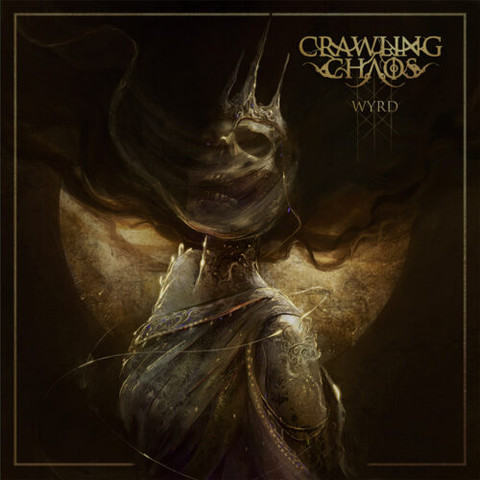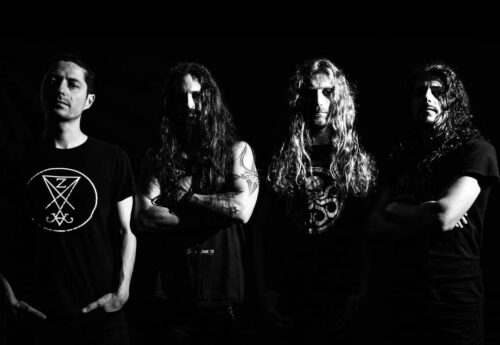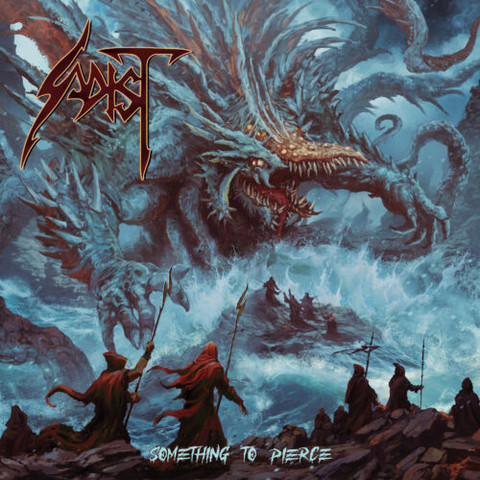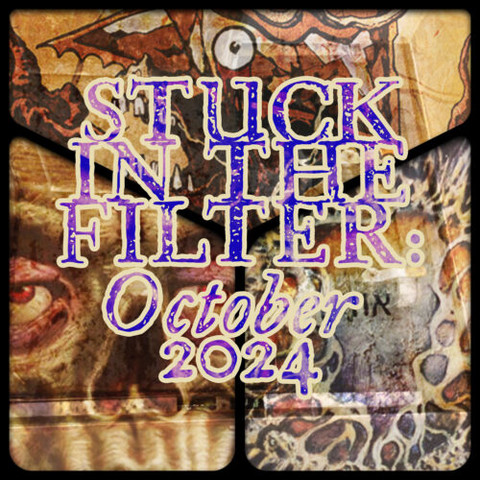By Carcharodon
We all slow down in our old age. Our own Steel Druhm is no exception. As he closes in on his third millennium, he finds himself overwhelmed more and more often.1 And so verily it came to pass that, to help out our tiring patriarch, Dolph and I agreed to double team his beloved Italian psych-doom weirdos, Messa.2 To be fair, this is no hardship. All three of Messa’s albums to date have been absolutely killer, from the drone-doom of debut Belfry (2016), through personal fav, the post-bluesy Feast for Water (2018) to progressive opus Close (2022). To say the band is enigmatic would be something of an understatement. The quartet, which has held together without any line-up changes for over a decade, seamlessly knit together a dizzying array of styles, modulating the focus on each release. Where will the dial land on fourth outing, The Spin?
If you’re looking to place The Spin in Messa’s discography, it’s probably closest in tone to Feast for Water. However, it’s a smoother experience. Rather like using a velvetiser to make your hot chocolate. It’s still hot chocolate. But it’s thicker, richer, and, well, velvet-ier. The Spin has been velvetised in two key ways. First, Sara’s smouldering, siren-like vocals have hit a whole new level, with the power on her sustains (“Fire on the Roof” and “Void Meridian,” in particular) imbuing The Spin with such a sense of power. Secondly, guitarist Alberto has leant harder into the progressive doom of Vanishing Kids, paired with the languid blues of his solo debut (Little Albert’s Swamp King), all buried in a guitar tone that Pink Floyd would be delighted by (“Reveal” and the gorgeous back end of “Immolation”). Where Feast had a slightly roughened, old-school Trouble or Pentagram edge to its haunting, crooning vibe, Messa are now operating in bigger, more expansive—and, frankly, more expensive-sounding—territories, recalling the likes of recent Green Lung (“At Races”) and Beth Hart (“Fire on the Roof” and “Immolation”).
And yet, Messa are still unmistakably Messa. From the yawing electronica that opens The Spin on “Void Meridian,” through The Gathering-meets-psychedelic-lounge-jazz of “The Dress” to the oppressive, brooding heaviness of closer “Thicker Blood,” the constantly shifting sonic palette draws on soundscapes that are familiar from each record in the band’s back catalogue. At the same time, The Spin is more anthemic than previous albums, with almost-nailed-on song o’ the year “Fire on the Roof” leading the way, its huge, trad doom chorus a thing of beauty, while the smoky, mesmerising verses find Sara almost chanting. In fact, “Fire…” is the start of a three-track run that, for me, is pretty well the best material Messa has written, as it leads into the fragile keys and bluesy, cathartic build of “Immolation” before “The Dress” hits. It is this that sets The Spin slightly apart from previous Messa albums, which have an organic flow to them, where this latest offering feels slightly more like a collection of songs.
While The Spin does feel less like a single, flowing composition than previous Messa records, it doesn’t lack cohesion, and the massive, standout highs offer plenty of compensation for that slight loss in flow. This may be explained by the fact that, unlike Close, the band chose to record this album separately, across several locations and periods, with (apparently) a lot of rearrangement of the material to get to the finished record. Messa also focused on simplifying and stripping back the song structures, which makes them more digestible. Although there are no weak songs on The Spin, opener “Void Meridian” lacks bite and never quite hits its stride, while penultimate cut “Reveal” feels like it belongs on an earlier Messa album, particularly in its chugging middle passage. I touched above on the beautiful guitar tone that Alberto and Mark Sade have found, so thick and meaty you can practically bite into it. Apparently, the band focused on using as much original 80s equipment as possible, which could have something to do with it.
At this point, it’s becoming apparent that Messa basically can’t miss. Whatever they turn their hand to, they manage to retain their identity, while writing diverse, interesting and, most importantly, absolutely banging albums. The Spin is no exception, from the bright, propulsive energy of “At Races” to the stark beauty of “Immolation,” Messa have done it again. At a tight 43 minutes, this album races by and, when it finishes, the only reason I don’t simply start it again is that I usually want to listen to “Fire on the Roof” a couple of times first. Less challenging and more immediate than previous records, but no less beautiful for it, The Spin perhaps shows the influence of bigger label Metal Blade on the band. I hope it earns them some deserved dollar bills.
Rating: 4.0/5.0
DR: 6 | Format Reviewed: 256 kbps mp3
Label: Metal Blade Records
Websites: messa.bandcamp.com | facebook.com/MESSAproject
Releases Worldwide: April 11th, 2025
Dolphin Whisperer
My brother-in-law loves metal, and I don’t think he’d be offended if I were also to say that he’s not particularly invested in finding new metal to listen to in the modern scene. However, on one ride in the car, I had Messa’s 2022 opus Close on at a moderate volume, prompting him to investigate what exactly was enchanting his ears. After that outing, he and my sister returned to their home, another five-plus hour drive, and she sent me a text saying that they binged Messa’s discog a couple times on the way back; he was in love. You see, despite the quirks that give Messa their mystical air, the crafty Italians possess the secret to all great rock music: volume-scaling power, a unique and soaring vocal presence, and big, fat hooks. The Spin, of course, is no exception.
In that regard, Messa follows their own lineage by never delivering the same album twice. The journey from post/drone atmospherics of Belfry to the heavier occult/doom worn Feast for Water to the MENA jazz-loaded snake charming Close, each entry in their catalog serves as an ode to their inherent tendency to experiment while holding true to a base of doom weight and rock attitude. Vocalist Sara Bianchin has transformed alongside Messa’s journey too, with her earliest performances reflecting the youth of her experience in rawer mic reflections. But The Spin leans on sounds from the ’80s, and, in turn, Bianchin’s now studied attack runs recklessly through swirling and swelling layers of echo and shrill serenade. Elsewhere, chorus pedal abuse, gothy reverb, and low-end synth propulsions mark The Spin’s throwback dance in the Messa stride—Disintegration-echoing bass leads (“Void Meridian,” “At Races”) crashing against Tears for Fears brooding throbs (“The Dress,” “Thicker Blood”) running through call-and-response guitar lead explosions (every. song.). It’s easy to fall prey to the sense of nostalgia that such sounds stimulate.
However, in a sense of reverence for the past, not just a wistful longing, The Spin weaves its own home in familiar textures. Messa finds a comfort in dreamy textures indebted to foundational post-punk works—those of The Sound or Joy Division—while still injecting a metallic edge of heavyweight chord drives and aggressive rhythms (“Fire on the Roof,” “Thicker Blood”). Doom anchors the drama, as always, in slow builds and syllable stretches that crawl and lurch against Messa’s chosen palette of Roland-modulated simmers and proto-shoegaze dissonance (“Void Meridian,” “The Dress”). And, of course, Messa lives life in the fast lane switching and melding identities on a dime, with late album cut “Reveal” pairing a heavy blues twang, frantic bursts of blast beats, and Bianchin’s wailing narrative for an anachronistic detour that both upends and upholds The Spin’s playful historical lens.
As Messa’s shortest album to date, The Spin’s seven cuts go down smooth but lacking in the kind of wholeness that other works have held. On one hand, it’s easy to work in The Spin to whatever length of time allows—a quick hit or two of your favorites as you dress for the day ahead, a longer commute as the sun moves from straight in the eyes to waving from the side, a jog around the neighborhood with canine companions. Movement, or rather transience, sits at the core of Messa’s themes here after all: the chase for meaning in a strained world (“Void Meridian”), the weight of choice that can’t decide a push or pull (“Immolation”), and accepting what lurks around the corner (“Thicker Blood”). And so The Spin demands more as an encapsulation of wandering, but it’s a human quest that’s easy to indulge as you see fit.
Neither a slow-burn nor a peel out, The Spin saunters at a breathing, bustling pace that manages to hustle ahead of a growing movement gazey and hazey doom wielders. I, too find solace in genre cousins like the jazzy and equally textured Moths or the pleading missions of Slumbering Sun, but Messa continues to find ways to wield weaponized guitar heroism, fat-bottomed tones, and sultry synthesis in a way that feels true to their growing discography while reaching to new fans and new sounds. Music this powerful stands ready to inspire binge listening, tone envy, and, with any luck, another generation hopelessly addicted to six strings screaming at unadvisable volumes.
Rating: 4.0/5.0
#2025 #40 #Apr25 #BethHart #Blues #DoomJazz #DoomMetal #Eagles #GothicRock #GreenLung #HeavyMetal #ItalianMetal #JoyDivision #LittleAlbert #Messa #MetalBladeRecords #Pentagram #PinkFloyd #postPunk #PsychedelicRock #Review #Reviews #TearsForFears #TheCure #TheGathering #TheSound #TheSpin #Trouble #VanishingKids

















